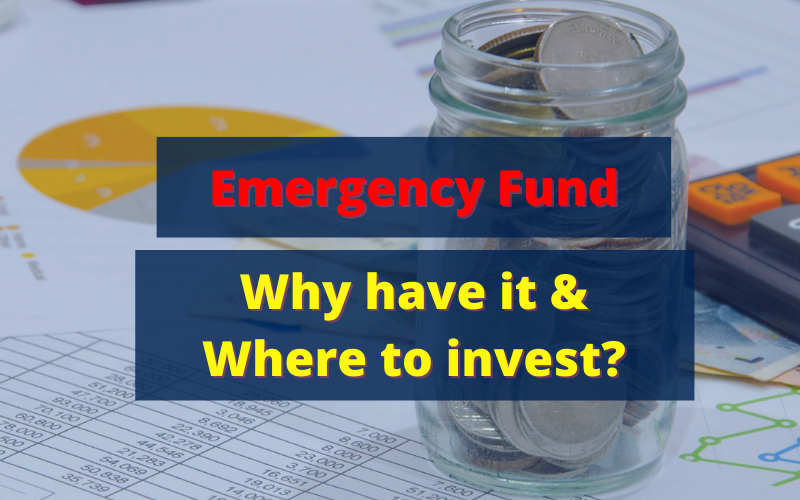An emergency fund is a saving to be kept separately for unplanned expenses. The unexpected expense may come in any form, like job loss, parent’s support, or even unplanned bills or payments that are not part of your regular monthly expenses and spending.

Table of Contents
Why Have an Emergency Fund?
It is essential to have an emergency fund because it serves as a safety net for unexpected financial events and can help prevent you from going into debt. Having an emergency fund is a must and an essential element of your financial foundation. In this article, I have talked about “emergency fund: where to invest and why have it,” which is very important to be strong to take care of any unexpected financial need.
Losing a job or dropping in sales in a business can be a devastating experience, and having an emergency fund can help ease the financial burden during this difficult time. The emergency fund can provide income until you find new employment or your sales recover. It can also cover expenses such as job search and business marketing costs.
How Much Emergency Fund Should You Have?
One critical factor influencing your decision-making regarding how much emergency fund corpus you should have is your work profile (salaried employee or business owner).
For employee
The emergency fund basket should equal a minimum of 6 months to 1-year expenses.
Why a minimum of 6 months?
They have a high chance of getting another job in 6 months.
For business owners
Business owners need to be ready with 1-year personal expenses and min 6 months for business emergencies. In case of unplanned expenses or less in business, sales can still smoothly go through the rough path.
An emergency fund for business will also help owners avoid immediate layoffs in case of a dip in sales.
Emergency Fund Where to Invest?
When deciding where to invest an emergency fund, it’s essential to consider two main factors: safety and liquidity.
Safety
Safety refers to the risk of losing money. So one has to be careful about investing the fund in a safe place, so the principal is not at risk. In this case, one can keep the amount in a savings account.
Liquidity
Liquidity refers to how easily and quickly you access your money. Keeping your money in a savings bank is considered liquid and can be accessed anytime. However, there is a concern if you park your entire emergency fund in a bank.
- As money is liquid and very much visible daily, you may spend some money because of human behavior.
- Your bank relationship manager (RM) may keep calling you and try to pitch you different investment options. You may tell them that this money is unavailable for investment as you have parked it for your emergency.
- Your money may not grow close to the rate of inflation.
So, here is the solution to how you should park your emergency fund.
Park in savings bank account – 10%
Park in liquid / Arbitrage mutual fund – 90%

Liquid Fund
Liquid Funds are debt mutual funds that invest in securities with a residual maturity of up to 91 days. Liquid funds invest in debt and money market instruments such as Commercial Paper (CP), Certificate of Deposit(CD), Treasury Bills(T-bills), etc., with residual maturity of 91 days only.
Arbitrage Fund
Arbitrage Funds fall under the hybrid mutual fund category and follow an arbitrage strategy, with a minimum 65% investment in equity and equity-related instruments. For taxation purposes, an arbitrage fund is an equity-oriented fund, as the underlying asset for arbitrage is more than 50% equity. However, from the risk point of view, it is a low-risk investment.
Note: Arbitrage fund takes a minimum of three workings (T+2) days for funds to get credited. Use the pro tip mentioned below if you choose to park the funds in an arbitrage fund or even for liquid funds to be on the safer side).
This way, by parking an emergency fund combining savings bank and mutual funds can help you avoid spending money on other needs, your bank RM will bother you to invest, and you will be able to generate a better return on investment (ROI) than a savings bank account.
💡Pro tip:
Having a credit card can help you big time during an emergency. You can pay your bills using a credit card, then later withdraw your parked emergency fund and pay the credit card due balance before the due date.
Using a credit card is not bad, but you must know how to use it properly to benefit you and avoid falling into a debt trap.
Ultimately, the best place to invest an emergency fund is somewhere that is safe and easily accessible when you need it. Finding a balance between earning interest close to or equivalent to inflation and having easy access to your funds when an emergency occurs is important.
Steps for Building an Emergency Corpus
- Make a budget and find out your basic monthly expenses.
- Determine where you can reduce your expenses and route the same towards savings.
- Start saving in a separate bank account for a month and then automate the savings into a liquid/arbitrage mutual fund.
- Whenever you use the emergency fund, re-fill it with the same amount to be ready for the next emergency.
Conclusion
An emergency fund is a crucial part of a comprehensive financial plan and can help protect you from financial hardships. It is essential to have an emergency fund to cover unexpected expenses and provide a safety net for job loss. When deciding where to invest an emergency fund, it’s essential to consider safety and liquidity.
Important Articles related to Personal Finance
- Income Tax New Regime Or Old Regime: For Salaried Employees
- Money management tips for beginners
- Tax Planning For Salaried Employees
- Investment Planning For Salaried Employees
- Mutual Fund KYC Online Registration
- How To Invest In Direct Mutual Funds?
- How To Start SIP Investment In Mutual Funds?
- 5 Mutual Fund Types: Learn To Choose The Right Fund For You
Important Calculators
Frequently Asked Questions
✓ What is an emergency fund?
An emergency fund is a saving to be kept separately for unplanned expenses. The unexpected expense may come in any form, like job loss, parent’s support, or even unplanned bills or payments that are not part of your regular monthly expenses and spending.
✓ How much to save in the emergency fund?
6 months to 1 year of expenses is an ideal amount to save as your emergency fund kitty.
✓ 4 mistakes to avoid while building an emergency fund
1. Not saving enough.
2. Not keeping fund liquid.
3. Choosing risky and high-interest instruments for savings.
4. Using emergency funds and not refilling.






